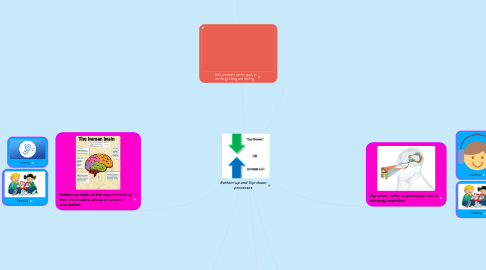
1. In English Classroom
1.1. A top-down approach would begin by immersing students in all aspects of learning English.
1.2. A bottom-up approach would begin with things such as phonics, letters, vowels and syllables...
2. Bottom-up refers to the way it is built up from the smallest pieces of sensory information.
2.1. listenig
2.1.1. Bottom-up processing proceeds from sounds to words to grammatical relationship lexical meaning, etc., to a final "message"
2.2. Reading
2.2.1. In Bottom-up processing, readers must first recognize a multiplicity of linguistic signals (letters, morphmes, syllables, words, phrases, grammatical cues, discoursemarkers) and use their linguistic data-processsing mechanisms.
3. Bottom-up
3.1. Example (listening)
3.1.1. The teacher reads out a number of sentences, and asks learners to write down how many words there would be in the written form.
3.2. Example (reading)
3.2.1. Asking learners to read aloud may encourage bottom-up processing because they focus on word forms, not meaning.
4. There are two general processes involved in sensation and perception.
5. Both processes can be apply in teaching Listenig and reading .
6. Top-down refers to perception that is driven by cognition.
6.1. Listening
6.1.1. Top-down precessing is evoked from "a bank of prior knowledge and global expectations" (Monley, 1991a, p. 87) and other background information (schemata) that the listener brings to the text.
6.2. Reading
6.2.1. Top-down, or conceptually driven, processing in which we draw on our own intelligence and experience to understand a text.
7. Top-down
7.1. Example (listening)
7.1.1. Activities include putting a series of pictures or sequence of events in order, listening to conversations and identifying where they take place
7.2. Example (reading)
7.2.1. The teacher will ask about the pictures shown and their experiences based on their previous knowledge.
